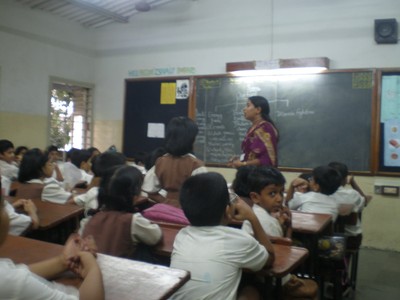
Big questions from Small Science !!
17-9-2008
Besides opportunities given through activities, the final exercise in each chapter of Small Science is, “Ask a Question”. Curious to see what kind of questions the children may have posed on their own, I looked at a few students’ workbooks. I found that their questions fall in some common categories:
1. Rhetorical (Questions of the kind in which intended answer is known from the facts given, and is often “Yes, of course” or “No”)
Examples from the students’ workbook are:
- Is there air inside earth?
- Is there air on the moon?
- Would we live without air?
These are questions whose answers the children knew from the start or which the lesson has already helped them figure out. The children probably scribbled them off because they are used to such questions, which serve an evaluative role in the examinations.
2. Apparently Tautological (Questions seem circular)
- These are questions of the type:
- Why vitamins are disease fighters?
- Why your body [sic] needs energy and body building?
- Why is food tasty?
These questions appear tautological, in the sense that they simply re-phrase textbook statements in the form of questions. But if I assume that the children meant how are vitamins disease fighters or how our body gets energy giving and body building material, the question becomes more answerable…let me try to answer this question as simply as I can here..
How are vitamins disease fighters?
Vitamins are very important for us to remain healthy…to maintain our cells, tissues and organs. There are many processes (cellular reactions) that help to break down and process our food (which include energy yielding as well as body building food) so that our cells can absorb them and produce energy and body building material. Vitamins help in making these processes happen(acting as catalysts). However, vitamins are not made in our body and therefore we need to consume vitamin-rich food. If we don’t do that, our body becomes weak because the energy producing and body building processes don’t take place effectively and therefore we get vitamin-deficiency diseases.
I remember while cereals were being discussed in class III the teacher said,’ cereals are energy givers and they are made up of carbohydrates’ and one of the students said ,’ I have heard about it but I don’t know what it is…’ . I also remember a student asking the teacher what really happens to the food when it gets absorbed. I will try to club these questions with the other question…How does our body get energy giving and body building material?
The energy giving foods that we eat are largely made up of carbohydrates which are made up of chains of a sugar called glucose. After we chew food and swallow it, the food goes into the stomach and then to the intestine where the food gets broken down into smaller chains. These chains further get broken into glucose. The glucose then gets absorbed into the blood and from there it is transported to the cells of different organs. Inside the cell, the glucose gets converted into other chemicals (glycolisis and krebs cycle) and during the process carbon dioxide and water are formed and energy is synthesized in the form of a chemical called ATP.
Pages 111-113 of the teachers book also has some extra information on vitamins, proteins and carbohydrates.
Why is food tasty?
Well…this is a tough one and I had to hunt around quite a bit to get answers to this question…well, I came across an online book which tries to understand the evolution of human taste. According it we are naturally hardwired to have a predilection for sugars and fats because they are a source of calories whereas we have an aversion for bitter taste because plant toxins are mostly bitter. This, along with our highly developed memory may have encouraged us to explore and document what tastes are good or harmful for us. Also, After the discovery of fire, our culinary experiments with basic tastes began and there has been no looking back!
3. Teleological (Questions which require recourse to a final cause)
Examples include:
- ‘Why god has gave [sic] us bones?’
- ‘Why god has gave [sic] us hands?’
There is no scientific evidence yet for ultimate causes. I asked Prof. Nagarjuna how one can respond to questions like these…he told me that one way would be to narrow them down and give them some direction like ask them, ‘why would god give us bones?….it could also be your mother’ thus directing their attention to a more immediate cause. Another way could be to draw children’s attention to what functional advantage bones give us for support or movement and what it would be like to exist without bones.
An evolutionary explanation of how bones evolved is available in this article…
http://journals.cambridge.org/download.php?file=%2FBJN%2FBJN6_01%2FS0007114552000474a.pdf&code=bfde982e814dcdf1799cf8f415584175
According to it, in ancient vertebrates, the function of the bone was largely protective, being endowed with exoskeletons (external structure that protects the body) that were bony. Some of these organisms eventually lost their exoskeletons as is the case of bony fishes where the bony exoskeletons were replaced by scales and fins. Some of these were also able to acquire a large body size because the loss of the rigid outer covering and probably evolved to become the present day terrestrial vertebrates. The article says that although the evolutionary account seems plausible there are some gaps and contradictions that need to be resolved.
Well, I must say that the questions that children ask are no trivial matter and some of them may even by questions that scientists dont have answers to…but it is indeed possible to help children answer them…
— Aswathy Raveendran
One September morning when I walked into class IV, the teacher was wrapping up the History lesson. There were some “question-answers” on the board which the children were busy copying down into their notebooks. I was struck by how strikingly different the Small Science approach is …designed to encourage the natural tendency of children to ask questions, not to seek tailor-made answers.



